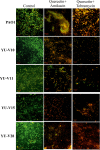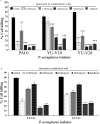Potential synergistic activity of quercetin with antibiotics against multidrug-resistant clinical strains of Pseudomonas aeruginosa
- PMID: 33156838
- PMCID: PMC7647105
- DOI: 10.1371/journal.pone.0241304
Potential synergistic activity of quercetin with antibiotics against multidrug-resistant clinical strains of Pseudomonas aeruginosa
Abstract
Development of drug resistance in opportunistic pathogens is one of the major healthcare challenges associated with infection management. Combination therapy has many advantages due to the simultaneous action of two drugs on two separate cellular targets. However, selection of the drugs should offer safety and synergistic interaction against most of the strains. Here, the efficacy of antibiotics in combination with quercetin, a natural flavonoid capable of targeting quorum sensing was tested against biofilm-forming Pseudomonas aeruginosa strains previously isolated from catheter associated urinary tract infection. Based on the antibiotic susceptibility pattern, synergistic effect of quercetin with selected antibiotics (levofloxacin, ceftriaxone, gentamycin, tobramycin and amikacin) was tested at the fractional concentrations of MIC by the checkerboard method and the fractional inhibitory concentration index (FICi) was calculated to estimate the synergistic effect. Effect of the synergistic combinations were further tested using time-kill assay, and against biofilm formation and biofilm cell viability. Cytotoxicity assays were performed using Human Embryonic Kidney 293T cells (HEK-293T) using the effective drug combinations with respective controls. The biofilm formation and biofilm cell viability were drastically affected with quercetin and selected antibiotics combinations with ≥80% inhibition. In vitro infection studies showed that all the strains could exert significant cell killing (68 to 85%) and the drug combinations decreased the infection rate significantly by reducing the cell killing effect of P. aeruginosa (p<0.05). The synergistic effect of quercetin is attributed to its quorum sensing inhibitory properties. These findings indicate that quercetin along with existing antibiotics can potentiate the treatment against P. aeruginosa infection and may reduce the selection pressure due to antibiotic overuse.
Conflict of interest statement
The authors have declared that no competing interests exist.
Figures







References
Publication types
MeSH terms
Substances
LinkOut - more resources
Full Text Sources
Medical
Miscellaneous

